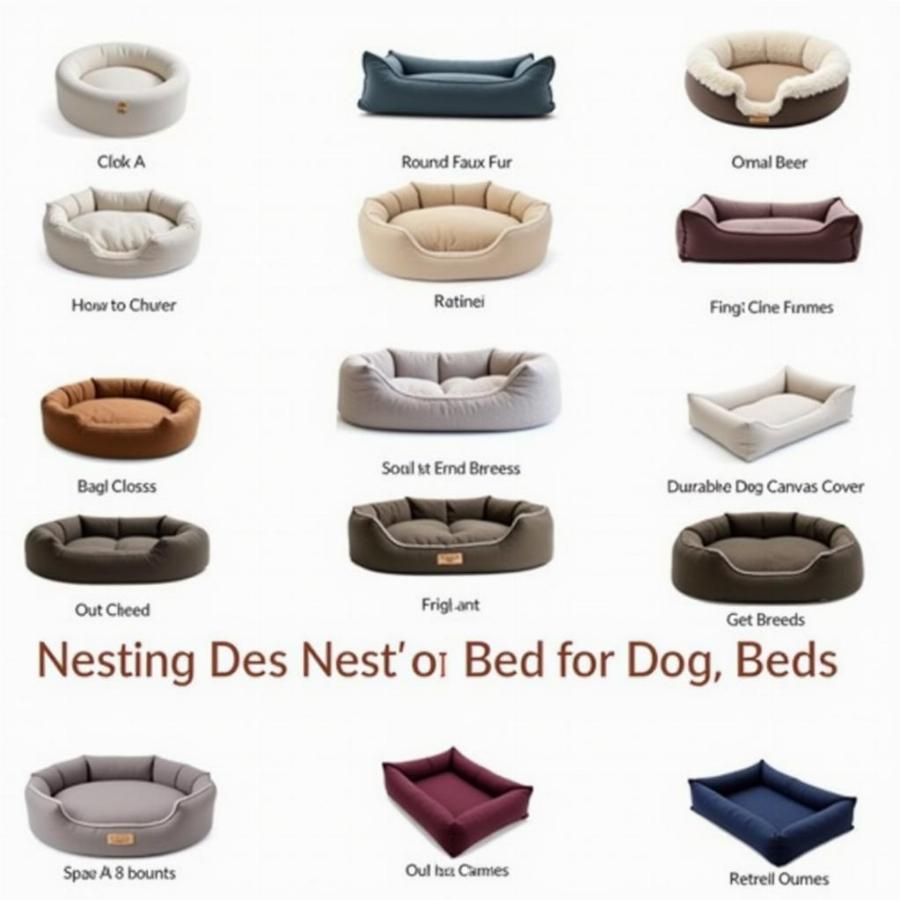Nesting beds for dogs, also known as bolster beds or donut beds, are designed to provide ultimate comfort and security for your canine companion. These beds feature raised edges that create a sense of enclosure, mimicking the feeling of being snuggled up against a mother or pack members. This design is particularly appealing to dogs who enjoy curling up or leaning against something while they sleep. Choosing the right nesting bed can significantly improve your dog’s sleep quality and overall well-being.
Understanding the Benefits of Nesting Beds for Dogs
Why are nesting beds so popular? They offer a range of benefits beyond just comfort. The raised sides of the bed provide support for your dog’s head and neck, which can be especially helpful for senior dogs or those with joint pain. The enclosed design also helps to retain your dog’s body heat, keeping them warm and cozy during colder months. This feeling of security can be particularly beneficial for anxious dogs, helping them to feel more relaxed and safe.
For puppies, a nesting bed can provide a sense of familiarity and comfort as they transition to their new home. The soft, plush materials and enclosed design can help to ease separation anxiety and promote restful sleep. Furthermore, nesting beds can also help to contain shedding and keep your dog’s fur off your furniture.
Choosing the Right Nesting Bed: Size, Material, and Filling
Selecting the appropriate nesting bed for your dog depends on several factors, including their size, breed, and sleeping habits. Measure your dog from nose to tail while they’re lying down in their preferred sleeping position. Add a few inches to this measurement to ensure the bed is spacious enough.
Size and Breed Considerations
Different breeds have different sleeping preferences. For instance, larger breeds like Great Danes or Mastiffs might prefer a rectangular nesting bed with extra room to stretch out. Smaller breeds, like Chihuahuas or Yorkies, might feel more secure in a smaller, round nesting bed.
Material and Filling Options
The material and filling of the nesting bed are also crucial for comfort and durability. Look for durable, washable covers made from materials like canvas, corduroy, or fleece. blanket bed for dogs can also offer similar comfort. Common fillings include memory foam, polyester fiber, and shredded foam. Memory foam conforms to your dog’s body, providing excellent support for joints and pressure points.
 Các Loại Nesting Beds Cho Chó
Các Loại Nesting Beds Cho Chó
Cleaning and Maintaining Your Dog’s Nesting Bed
Regular cleaning is essential to keep your dog’s nesting bed hygienic and free from allergens. Most nesting beds have removable, washable covers. Follow the manufacturer’s instructions for washing and drying. If the bed itself is washable, be sure to air dry it thoroughly to prevent mold and mildew growth. Knowing why do dogs scratch their beds can help you maintain their bedding better.
Addressing Common Issues: Chewing and Digging
Some dogs have a tendency to chew or dig on their beds. This behavior can stem from anxiety, boredom, or simply instinct. Providing plenty of chew toys and engaging in regular exercise can help to redirect this behavior. You can also find out why do dogs dig on beds and couches for a better understanding.
Do dogs like nesting beds?
Yes, many dogs enjoy the comfort and security of nesting beds.
What is the best filling for a dog nesting bed?
Memory foam and polyester fiber are popular choices for their comfort and support.
How do I choose the right size nesting bed for my dog?
Measure your dog from nose to tail while they’re lying down and add a few inches.
Conclusion
Nesting beds offer a cozy and secure sleeping environment for dogs of all ages and breeds. By carefully considering factors like size, material, and filling, you can choose the perfect nesting bed to provide your furry friend with the ultimate comfort and support. why do dogs scratch and why do dogs dig their beds are important considerations when choosing bedding. Investing in a high-quality nesting bed can contribute significantly to your dog’s overall well-being and ensure they enjoy many nights of restful sleep.
FAQ:
- Are nesting beds good for anxious dogs? Yes, the enclosed design can provide a sense of security.
- Can nesting beds be washed? Most have removable, washable covers.
- What materials are nesting beds typically made of? Common materials include canvas, corduroy, and fleece.
- Are nesting beds suitable for puppies? Yes, they can help ease separation anxiety.
- What are the benefits of a memory foam nesting bed? Memory foam provides excellent support and conforms to your dog’s body.
- How often should I wash my dog’s nesting bed? It depends on usage, but generally every few weeks is recommended.
- Can nesting beds help with shedding? Yes, they can help contain loose fur.
Beaut Dogs is your trusted source for all things dog-related. We offer expert advice and guidance on dog breeds, care, and products. Visit Beaut Dogs today for more valuable information and resources to help you provide the best possible care for your beloved companion. When you need support, contact us by Email: [email protected] so that Beaut Dogs can answer in detail and accurately. (This is an email address).